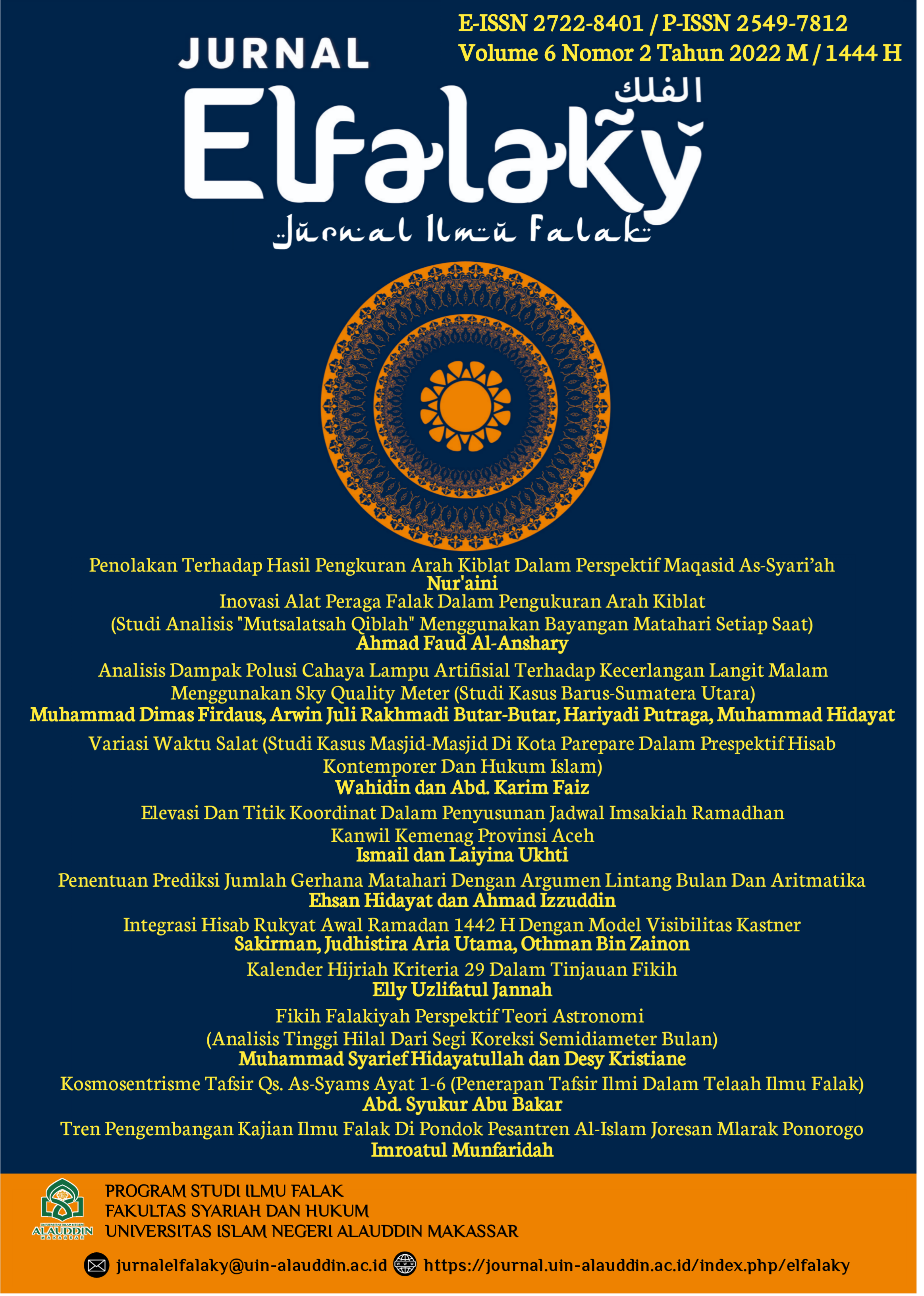PENENTUAN PREDIKSI JUMLAH GERHANA MATAHARI DENGAN ARGUMEN LINTANG BULAN DAN ARITMATIKA
Abstrak
Variation in the number of solar eclipses is one of the number phenomena that occurs every year. Territorially, eclipses can occur and be observed once or twice and globally, solar eclipses can occur in quantities of 2 until 5. There are several literatures that say the minimum-maximum number is different from the data above. With a statistical approach, this paper examines one of the important components of the initial eclipse prediction algorithm, which is the value of the argument of moon’s latitude symbolized by large F and through arithmetic used to find a pattern of variations in a number. There are two interesting findings, the first argument of moon’s latitude value has a regular number pattern on each lunation, which is increased by 30,6705. Second, if in general people have to predict eclipses every month, then this study suffices data from the beginning of the new moon in a year, to be able to find out the eclipse in the months after or before.
Referensi
Admiranto, A. Gunawan, Menjelajahi Tata Surya, Yogyakarta : Kanisius, 2009.
Al-Bukhary, Abi Abdillah Muhammad ibn Ismail, Matnu Masykul al-Bukhary, Beirut : Dar al-Fikr, Jilid I, 1994.
Anugraha, Rinto, Mekanika Benda Langit, Yogyakarta : Jurusan FMIPA UGM, 2012.
Bird, John, Matematika Dasar : Teori dan Aplikasi Praktis, Jakarta : Erlangga, 2004.
Djamil, Ilmu Falak (Teori & Aplikasi), Jakarta : AMZAH, 2009.
Espenak, Fred, Thousand Year Canon of Solar Eclipses 1501 to 2500, USA : Astropixels Publishing, 2017.
Fathullah, Ahmad Ghozali Muhammad, Tsamrotu al-Fikr, Madura : LAFAL, t.t.
Hambali, Slamet, Ilmu Falak 1 : Penentuan Awal Waktu Shalat & Arah Kiblat Seluruh Dunia, Semarang : Program Pascasarjana IAIN Walisongo, 2011.
Izzuddin, Ahmad, Ilmu Falak Praktis, Semarang : PT. Pustaka Rizki Putra, 2012.
Kh. U. Sadykov, Abu Raihan Al-Biruni dan Karyanya dalam Astronomi dan Geografi Matematika, Jakarta : Suara Bebas, 2007.
Khairunnisa, Afidah, Matematika Dasar, Jakarta : Rajawali Press, 2014.
Khazin, Muhyiddin, Ilmu Falak dalam Theori dan Praktik, Yogyakarta : Buana Pustaka, t.t.
__________, Kamus Ilmu Falak, Yogyakarta : Buana Pustaka, 2005.
Littmann, Mark, dkk, Totality Eclipses of The Sun, New York : OXFORD University Press, 2008.
Marpaung, Watni, Pengantar Ilmu Falak, Jakarta : Prenadamedia Group, cet I, 2015.
Meeus, Jean, Astronomical Algorithms, Virginia: Willman Bell. Inc., 1991.
__________, Element of Solar Eclipses, Virginia : Willman-Bell, Inc., 1989.
Pusat Bahasa Departemen Pendidikan Nasional, Kamus Bahasa Indonesia, Jakarta : Pusat Bahasa, 2008.
Rasywan Syarif, Muh, Fikih Astronomi Gerhana Matahari, Sinopsis Tesis, Semarang : IAIN Walisongo, 2012.
Shodiq, Jafar, Studi Analisis Metode Hisab Gerhana Matahari Menurut Rinto Anugraha Dalam Buku Mekanika Benda Langit, Skripsi Fakultas Syari’ah Dan Hukum UIN Walisongo, Semarang, 2015.
Sugondo, Dendy, Kamus Bahasa Indonesia, Jakarta : Pusat Bahasa, 2008.
Syarif, Muh. Rasywan. Ilmu Falak Integrasi Agama dan Sains. Cet.I; Gowa: Alauddin University Press, 2020.
Wawancara:
Wawancara dengan Rinto Anugraha di kantor Jurusan Fisika FMIPA UGM pada tanggal 28 Desember 2016 jam 15.30 WIB.
Wawancara dengan Rinto Anugraha di kantor Jurusan Fisika FMIPA UGM pada tanggal 28 Desember 2016 jam 15.30 WIB.
Website:
https://eclipse.gsfc.nasa.gov/SEhistory/SEhistory.html diakses pada 8 Januari 2019 pukul 15.08 WIB.





